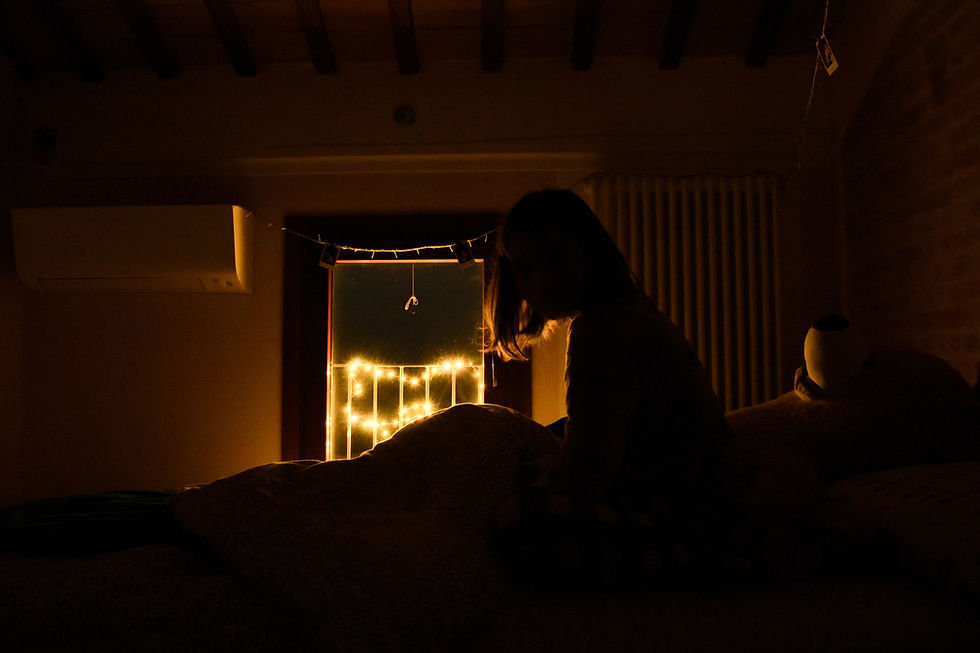Restless Legs Syndrome at Night: Causes, Symptoms, and Effective Treatments
- James Smurthwaite

- Mar 23
- 4 min read

Restless Legs Syndrome (RLS) is a frustrating and often misunderstood condition that disrupts sleep for millions of people. If you’ve ever felt an irresistible urge to move your legs while trying to relax at night, you might be dealing with RLS. This neurological disorder, also called Willis-Ekbom disease, tends to get worse in the evening and can make falling and staying asleep a nightly struggle.
In this blog, we’ll explore the causes of RLS, why it worsens at night, and the best ways to manage symptoms. Whether you’re searching for medical treatments, lifestyle changes, or natural remedies, this guide will help you find relief.
What is Restless Legs Syndrome at night?
Restless Legs Syndrome is a condition that causes uncomfortable sensations in the legs, often described as:
Crawling
Tingling
Burning
Aching
Electric shock-like feelings
These sensations typically occur when you’re sitting or lying down, making nighttime especially difficult. Moving the legs temporarily relieves the discomfort, but the symptoms return when you rest again. The result? A cycle of constant movement and broken sleep. According to the Sleep Foundation, RLS is one of the leading causes of sleep disturbances, contributing to chronic insomnia and daytime fatigue.
How Common is RLS?
According to the NHS, RLS affects around 5-10% of adults in the UK, with women more commonly affected than men. It can appear at any age, but symptoms usually worsen with time. Research from Johns Hopkins Medicine indicates that RLS may be underdiagnosed, with many individuals mistaking their symptoms for stress or muscle fatigue (Johns Hopkins Medicine).
Why Does RLS Get Worse at Night?
Many people with RLS notice that their symptoms intensify in the evening and peak at night. This happens due to several factors:
Circadian Rhythms: The body’s natural sleep-wake cycle influences dopamine production, which plays a role in RLS. Dopamine levels tend to dip in the evening, worsening symptoms.
Reduced Movement: During the day, walking or stretching helps keep RLS symptoms at bay. At night, when you’re lying still, the discomfort builds up.
Iron Deficiency: Iron is crucial for dopamine function in the brain. Low iron levels, especially at night, may contribute to more severe RLS symptoms. A study published in the Journal of Clinical Sleep Medicine found a direct link between low brain iron and increased RLS severity (JCSM).
What Causes Restless Legs Syndrome?
The exact cause of RLS is not fully understood, but researchers believe it’s linked to a combination of genetics, brain chemistry, and underlying health conditions. Here are the most common causes:
1. Iron Deficiency
Studies have found that people with RLS often have low levels of iron in the brain. Even if a blood test shows normal iron levels, the brain may still be iron-deficient.
2. Dopamine Dysfunction
Dopamine is a neurotransmitter that helps control muscle movements. An imbalance in dopamine levels, similar to what happens in Parkinson’s disease, can trigger RLS symptoms.
3. Chronic Health Conditions
Certain conditions are linked to RLS, including:
Diabetes
Kidney disease
Peripheral neuropathy (nerve damage)
Parkinson’s disease
Multiple sclerosis
4. Pregnancy
Many pregnant women experience RLS, especially in the third trimester. It is believed that hormonal changes and iron deficiency contribute to this, but symptoms often disappear after childbirth.
5. Medications
Certain medications can make RLS worse, including:
Antihistamines (found in allergy medications and sleep aids)
Antidepressants
Antipsychotics
Some anti-nausea drugs
If you suspect a medication is making your symptoms worse, speak to your GP about alternative options.
Treatment Options for Restless Legs Syndrome
While there’s no cure for RLS, various treatments can significantly reduce symptoms. These include lifestyle changes, medications, and alternative therapies.

1. Lifestyle Changes
Some simple adjustments can make a big difference:
Increase Iron Intake: If your iron levels are low, eating more iron-rich foods (such as spinach, lentils, and fortified cereals) or taking supplements may help.
Exercise Regularly: Light exercise, such as walking or yoga, can reduce symptoms, but avoid intense workouts close to bedtime.
Improve Sleep Hygiene: Keep a regular sleep schedule, make your bedroom comfortable, and avoid blue light before bed.
Reduce Caffeine and Alcohol: Stimulants can make RLS worse, so cutting back on coffee and alcohol may help.
2. Medications
If lifestyle changes aren’t enough, medications may be prescribed:
Dopamine Agonists: Drugs like ropinirole, pramipexole, and rotigotine can help regulate dopamine levels.
Iron Supplements: If a deficiency is detected, iron supplements can improve symptoms.
Gabapentin and Pregabalin: These drugs, originally used for nerve pain, have been found effective for RLS.
Opioids: In severe cases, low-dose opioids like oxycodone or tramadol may be prescribed, but these are usually a last resort due to addiction risks (Patient.info).
3. Natural and Alternative Remedies
Some people find relief through:
Magnesium Supplements: Magnesium helps relax muscles and may ease RLS symptoms.
Acupuncture: Some studies suggest acupuncture can reduce RLS severity.
Pneumatic Compression Therapy: Devices that apply pressure to the legs may help improve circulation and reduce symptoms.
Final Thoughts
Restless Legs Syndrome at night can be incredibly disruptive, but with the right strategies, you can regain control of your sleep. Whether through lifestyle changes, medical treatments, or natural remedies, there are effective ways to manage symptoms and improve quality of life.
If you suspect you have RLS, don’t suffer in silence—speak to a healthcare professional to explore your options and find relief.



Comments